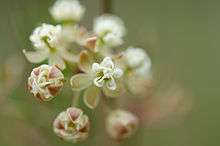Asclepias verticillata
| horsetail milkweed eastern whorled milkweed | |
|---|---|
 | |
| Scientific classification | |
| Kingdom: | Plantae |
| (unranked): | Angiosperms |
| (unranked): | Eudicots |
| (unranked): | Asterids |
| Order: | Gentianales |
| Family: | Apocynaceae |
| Subfamily: | Asclepiadoideae |
| Genus: | Asclepias |
| Species: | A. verticillata |
| Binomial name | |
| Asclepias verticillata L. | |

| Wikimedia Commons has media related to Asclepias verticillata. |
Asclepias verticillata (whorled milkweed, eastern whorled milkweed, horsetail milkweed) is a species of milkweed native to most all of eastern North America and parts of western Canada and the United States.[1]
Description
This is a perennial herb with a single stem 6 inches to 3 feet tall. The very narrow, linear leaves are arranged in whorls of 4-6 with short internodes. The inflorescence is a umbel of 7-20 greenish white flowers.[2][3]
Ecology
This species can reproduce vegetatively and does not depend on pollinators, but it does produce some nectar, mostly in the early evening hours. Insect visitors to the plant include wasps, honeybees, and lepidopterans such as moths and the Cabbage White.[4] Like other milkweed species, this plant is a host plant for the monarch butterfly whose caterpillars feed on the leaves.[5]
The plant is toxic to livestock.[3]
Uses
It was used as a medicinal plant by Native American peoples. The Choctaw used it to treat snakebite, the Lakota and Hopi used it to increase breast milk in nursing mothers, and the Navajo used it for nose and throat problems.[6]
References
- ↑ Asclepias verticillata. Germplasm Resources Information Network (GRIN).
- ↑ Hilty, John (2016). "Whorled Milkweed (Asclepias verticillata)". Illinois Wildflowers.
- 1 2 Asclepias verticillata. Native Plant Database. Lady Bird Johnson Wildflower Center. University of Texas at Austin. 2013.
- ↑ Willson, M. F., et al. (1979). Nectar production and flower visitors of Asclepias verticillata. American Midland Naturalist 102(1) 23-35.
- ↑ Monarch butterfly
- ↑ Asclepias verticillata. Native American Ethnobotany. University of Michigan, Dearborn.
